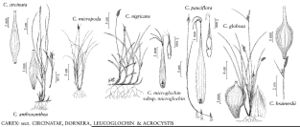Carex globosa
Proc. Linn. Soc. London 1: 259. 1845.
Plants loosely cespitose; rhizomes arching to ascending, dark reddish-brown to purplish brown, 0–12 mm, slender or stout. Culms 7–47 cm, scabrous distally; bases strongly fibrous. Leaf-blades bright green, usually shorter than stems, 1.4–4.5 mm wide, herbaceous, glabrous abaxially, strongly scabrous to papillose adaxially. Inflorescences usually with both staminate and pistillate spikes; peduncles of basal spikes arching, elongate, slender; peduncles of terminal staminate spikes 2–5 mm; proximal cauline bracts leaflike, usually shorter than (occasionally slightly exceeding) inflorescences. Spikes: proximal pistillate spikes 2–4 (basal spikes 1–2); cauline spikes overlapping or somewhat separated, with 3–10 perigynia; terminal staminate spikes 10–25 × 1.5–3.2 mm. Scales: pistillate scales purplish brown or reddish-brown, with similarly colored or narrow white margins, ovate, 4.2–6.5 × 1.8–2.1 mm, equaling or exceeding perigynia, apex obtuse to cuspidate (awned in some basal spikes); staminate scales ovate to lanceolate, 4.2–7.6 × 1.8–2.1 mm, apex obtuse to acute or short-awned. Anthers 2–3.3 mm. Perigynia green, 12–20-veined conspicuous to at least mid body, globose to obovoid, (3.5–) 3.8–5 × (1.6–) 1.8–2.3 mm; beak straight, pale green, often tinged with dark reddish-brown near apex, (0.5–) 0.7–1.4 mm, ciliate-serrulate, apical teeth 0.2–0.3 mm. Stigmas 3. Achenes brown, globose to obovoid, round to obtusely trigonous in cross-section, 1.9–2.7 × 1.6–2.3 mm.
Phenology: Fruiting mid Apr–late Jun.
Habitat: Moist, shaded, acidic and serpentine slopes and stream banks in redwood, cypress, pine, and oak forests
Elevation: 90–1500 m
Discussion
Selected References
None.
Lower Taxa
"shortened" is not a number.

